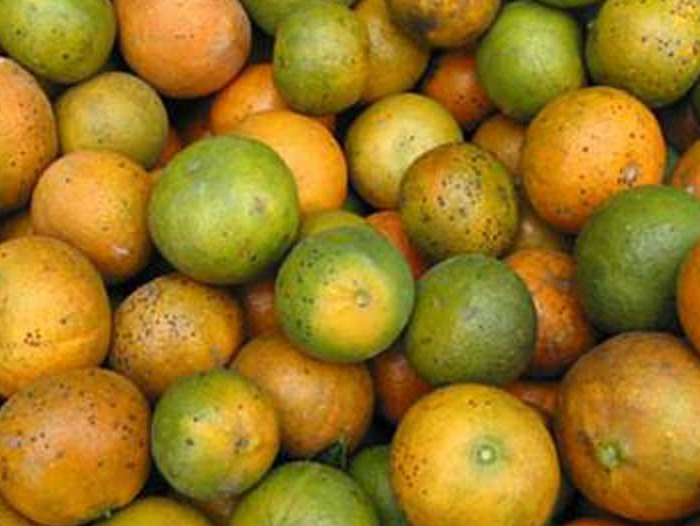Organic Center Study Zeroes in on Organic Ways to Beat Citrus Greening
January 24, 2019 | 4 min to read

Washington D.C. — Since it was first discovered in the United States in 2005, the bacterial disease known as citrus greening, or Huanglongbing, has devastated millions of acres of citrus crops throughout this country and abroad, ravaging citrus groves in Asia, Africa and South America.
Citrus greening has impacted conventional and organic growers alike, but its injury to organic growers has been especially deep because most of the efforts underway to keep the deadly disease in check involve methods that are prohibited in organic produce production. In addition, the research and work that have been done on organic-compliant ways to fight citrus greening have usually been conducted in non-organic settings and in combination with treatments prohibited by the organic standards, resulting in critical information not easily accessible to organic farmers and educators.
To help organic producers more effectively combat this disease that threatens their livelihoods, The Organic Center has released a paper that mines the existing body of scientific literature devoted to citrus greening, compiles relevant results and synthesizes them to create a farmer/nurseryman-focused document that pinpoints and details organic-compliant practices for combating citrus greening disease and the Asian citrus psyllid (ACP) insect, which carries the disease.
The study, funded by the UNFI Foundation and published in the January 20 issue of the scientific journal International Journal of Horticulture, Agriculture and Food Science, consolidates existing literature on allowable methods for combating citrus greening in organic groves.
“Organic citrus producers have suffered terrible losses from citrus greening, and they need to be aware of organic solutions to ward off this disease,” said Dr. Jessica Shade, Director of Science Programs for The Organic Center. “Our goal in releasing this paper is to help organic citrus growers fight this deadly disease without resorting to dangerous chemicals, genetic engineering or other methods not in compliance with organic standards.”
An organic solution
Citrus greening threatens the citrus industry on a massive scale. The highly destructive disease can spread quickly, and once a tree is infected, it cannot be cured.
Currently, the most common method for controlling citrus greening is by spraying large amounts of synthetic pesticides such as neonicotinoids. These toxic sprays have had only limited success, and have been responsible for large-scale bee die-offs. Other non-organic research has focused on creating GMO varieties of citrus trees resistant to citrus greening. But these conventional strategies have not yet proven effective and have contributed to policy decisions not compatible with organic management.
Organic citrus growers need ways to control citrus greening through organic practices, without the use of toxic chemicals or genetic engineering. The challenge is most research has focused on non-organic fields.
While research specifically targeted at the control of citrus greening in organic systems is very limited, numerous and diverse studies conducted in conventional systems have included non-chemical methods that potentially could be incorporated into organic protocols. However, because most studies that include organic compliant methods are usually done in non-organic settings and in combination with treatments prohibited by the organic standards, a significant effort is needed to find and extract the organic-relevant information embedded.
The Organic Center paper examines research from multiple citrus systems to distill the techniques allowed under organic certification to help control citrus greening. Examination of available literature, unpublished research data and grower observations have produced evidence that growers may be able to thwart the threat of citrus greening successfully in organic production to produce marketable fruit.
These organic strategies include combining strict disease prevention, diligent scouting, ACP control, nutritional support of healthy and infected trees, implementation of biological controls and the planting of cultivars considered tolerant or resistant to citrus greening.
But despite the strategies highlighted in the report that can help organic farmers combat citrus greening, Dr. Shade of The Organic Center stressed that more research is needed to overcome this terrible disease. “Conventional and organic farmers alike have had their groves decimated by citrus greening,” she said. “While our report provides tools for them to help them in their struggle, without more research we’ll continue to see a dramatic decline in citrus production – especially organic citrus.”
The Organic Center has been working with a team of growers, researchers and community members on the issue of citrus greening for several years. University of Florida (UFL) researchers and other individuals and groups contributing to the work on organic solutions for citrus greening include Ellen Cochrane (UFL), Professor Jawwad Qureshi (UFL), Professor Philip Stansly (UFL), Dr. Kim Bowman (USDA ARS), Professor Reza Ehsani (UFL), Professor Michael Rogers (UFL), Professor Ronald Brlansky (UFL), Professor Fritz Roka (UFL), Dr. Tracy Misiewicz, Ben McLean III (Uncle Matt’s Organic), and the Florida Organic Growers organization.
The Organic Center’s mission is to convene credible, evidence-based science on the health and environmental benefits of organic food and farming, and to communicate the findings to the public. The Center is an independent non-profit 501(c)(3) research and education organization operating under the administrative auspices of the Organic Trade Association.
